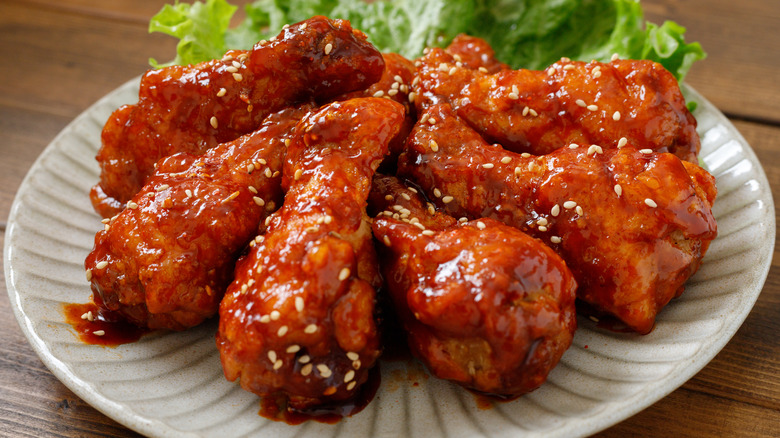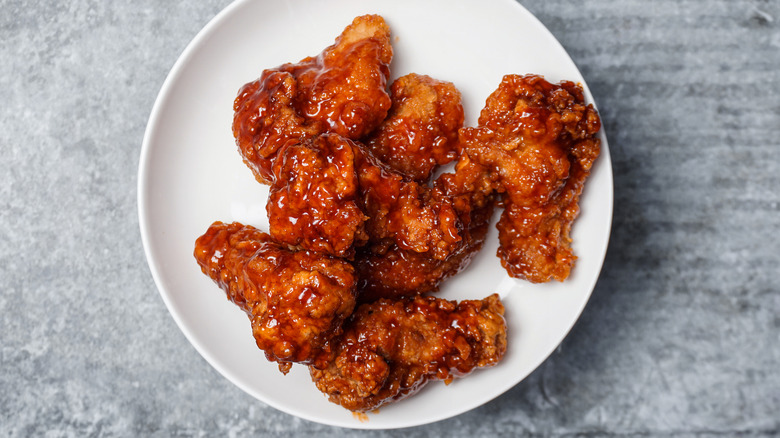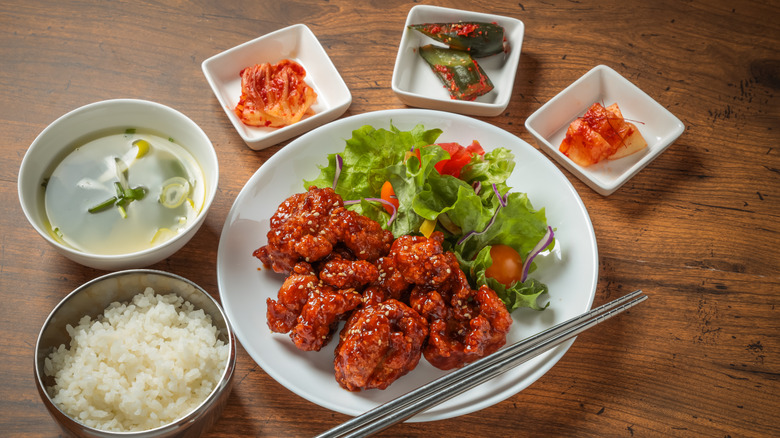Strawberry Jam Is The Unexpected Key To Sweetening Yangnyeom Sauce
Korea may be known as the land of the morning calm, but its love of high-heat sauces and tangy kimchi reflects anything but a sedate palate. We can thank this Asian peninsula for gochujang, doenjang, and ssamjang, each sauce a game-changing ingredient to liven up anyone's cooking. But it's time we give attention to yangnyeom, a spicy glaze that Koreans use to adorn their classic double deep-fried chicken.
Yangnyeom means "seasoned" in Korean, and when applied to fried chicken, it creates an irresistible dish worth the hype. The sauce itself is at once spicy, sweet, and tangy, complimenting any protein it touches and heightening the joy of divinely crisp Korean fried food. The usual suspects are all there — gochujang, soy sauce, and vinegar, but there may be a few surprises hidden within that shopping list. Case in point, strawberry jam. Indeed, a condiment we associate with buttered biscuits and toast works as the fruity backbone to this delicately spicy glaze. So what all goes into making your own Yangnyeom sauce? And what should you use it on once you have it?
How to make the Yangnyeom sauce
Like other Korean sauces, yangnyeom sauce walks that delicate line between sweet and spicy, combining hot ingredients, like chili flakes and gochujang, with sweet ones, like ketchup and honey. As yangnyeom is such a popular sauce in Korea, there are numerous variants of the sauce, with numerous ingredients to choose from.
One of the more classic versions uses the fruity sweetness of strawberry jam to add a tart complexity underneath the spicier elements. As an added bonus, it also helps thicken the texture of the sauce. Some particularly fruity takes use a combination of ketchup and strawberry jam, doubling down on the tangy sweetness. The spicy heart of the sauce is usually a combination of gochujang, a fermented red chili paste, and gochugaru, Korean red chili pepper flakes. Soy sauce comes in with a salty umami note, while rice wine vinegar adds in some acidity. Other additions may include spices like ginger, fresh garlic, sriracha, granulated sugar, corn syrup, and even cola.
An amalgamation of these ingredients will eventually get simmered on the stovetop until it becomes a silky glaze, coating the back of a spoon. With all the sugary ingredients, this process should take no more than two minutes, promising an epic condiment in almost no time at all.
Just add fried chicken
The most common use for yangnyeom sauce is to dress up Korean fried chicken, which can be applied with a heavy or light hand. Some recipes for Korean fried chicken call for moderate dipping, others for generous soaking, and still others claim that you need to brush the sauce on with a painter's delicate touch in order to maintain that crisp texture. Whatever you chose, you'll be creating some of the most flavorful fried chicken in existence.
But you can use this as a glaze for other things as well, like glossing a slab of pork belly or tenderloin, and even roast turkey. Yangnyeom also has a good reputation as a dumpling dipping sauce (called yangnyeom ganjang), as its sweet heat pairs well with fried or steamed varieties. One final idea? Go vegetarian and coat your next batch of roasted cauliflower or Brussels sprouts, or crispy tofu with this gorgeous sauce. It'll work wonders in highlighting the sweet and savory of your vegetable side dish.


